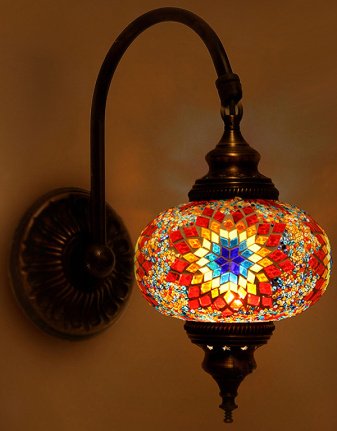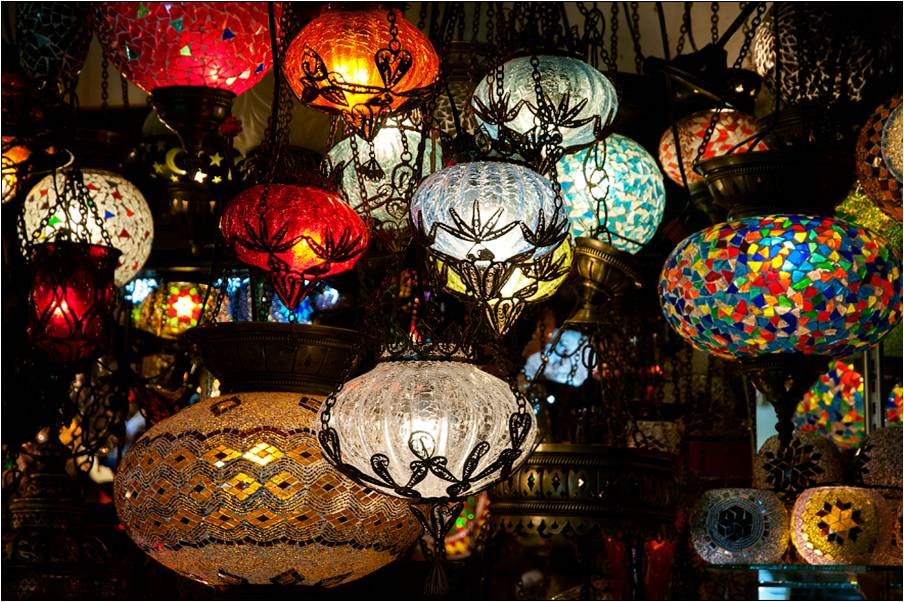History and technology of creating famous turkish mosaic lamps
All oriental legends, tales of a thousand and one nights are lit with bright patterns of these colored glasses! And this is not surprising! The history of this technique dates back to the 4th millennium BC. In ancient times, people said that mosaic paintings are dedicated to muses. As muses are eternal, so should these paintings have been eternal. Therefore, they were not painted with paint, but recruited from pieces of colored stone. Of course, in those days they decorated exclusively the homes of wealthy gentlemen, and instead of bulbs there were lights. By the way, you can use flashlights as candlesticks now.

However, more modern foreign lighting techniques, such as Bohemian glass (blown glass, the invention of Czech masters) or “glass ice” (technology invented by the Venetian glassblowers) surprisingly naturally fit into this aesthetic and took their rightful place next to the original Arabic mosaics. However, this happened already many hundreds of years ago and now such plafonds are also an integral part of the local flavor!
Since ancient times, mosaics have been used in Middle Eastern and Mediterranean villas, baths, temples, mosques and churches as a decorative element. The Romans and the Byzantines first mastered the technology and demonstrated examples of sophisticated and refined mosaics. Samples of the mosaic art of Ravenna and Pompei in Italy; The choirs of Hagia Sophia in Turkey still fascinate with their technology features and Turkish mosaic lamps those who saw them.
Mosaic lamps are an exquisite connection for those who still want to experience the authenticity of ancient times. Turkey is home to mosaic lamps and one of the most advanced manufacturers of mosaic chandeliers, sconces, pendants and lamps. More than 6000 years have passed since the moment when this art was born in Anatolia. For centuries, mosaic lamps have illuminated thousands of homes in Turkey, the Middle East and Europe.

By the way, the method of heating and cooling glass can significantly affect the resulting color. We use colored glasses for the manufacture of mosaic lamps, but do not use dyes, cutting large plates of colored glass with special scissors into small pieces, and then we create a picture from small parts and process them separately. Making these little pieces for mosaic shades is a craftsmanship. The production process of even the smallest mosaic candlestick takes 40 minutes.
Mosaic lights are great for shading. Most often oriental houses and gardens are decorated with Moroccan brass lanterns or other types of ancient lamps, but if you want to use mosaic lamps in your garden or on the porch of the house, then mosaic lamps will rotate in the air, lighting everything around with magical shades of the east.

They are also very relaxing as a night light. After a busy day, you can turn off the main lighting and have tea in the magical overflow of light from the mosaic lamp. Turkish Exotic Lamps will warm and give a stylish look to your living room, as well as help create an eclectic concept.
Mosaic lamps are now in trend – most Parisian, Italian, and more recently, New York apartments, as well as luxurious estates around the world, are decorated with mosaics in the bathroom. As the bedroom becomes in a sense a sanctuary, let it be day or night, you must design your bedroom in the most relaxing manner. By creating an appropriate atmosphere, you can relax and relieve stress in your bedroom.
Technology for manufacturing mosaic lamps
The manufacturing technology of the Mosaic has not changed: beads, tinted and non-tinted glass are used. Metal parts made of copper, filigree. Almost everything is made by hand. Drawings are usually more or less similar, but vary in color and shape.
Mosaic is perhaps the most versatile and very effective way of decorating surfaces. With the help of this design technique, you can suddenly make a bright accent from the most inconspicuous interior item, reflecting the creative nature of the owner.

Existing lampshades were trimmed with mosaic tiles, or a body was assembled from small glass elements into which a light source was inserted.
Most often, the mosaic technique is used to create ceiling chandeliers.
A simpler, but no less spectacular way of decorating a lamp with a glass mosaic can be mastered with your own hands using an ordinary glass vase. Its surface is carefully glued with glass chips (you can use colored or plain fragments), and the seams are wiped with a special transparent grout. The number of mosaic chips and the craft pattern are determined at the stage of sketch preparation. When you turn on the electricity, the light penetrating through these small “windows” into the room will fill the space with an incredible fairytale sensation.

Technical progress allows you to breathe modern technical stuffing into the old shell, while preserving the grace and warmth of the craftsman’s hands lovingly creating the charm of the play of mosaic light.
In the manufacture of fixtures, the most modern electrical components are used, which ensure reliable and safe operation of lighting devices.

The variety in the assortment allows the designer to fill the whole room with magic light, not to ignore any of its corners: ceiling chandeliers of various sizes and designs, harmoniously complement table lamps, floor lamps and wall sconces.
Turkish Mosaic lamps create a warm, romantic atmosphere. If the design provides for one lamp, it will look self-sufficient, if you assemble a skillful composition, it will be bright and memorable. Lampshades can be lit electrically or with a candle. They can also be used as a vase for fresh or dried flowers.

